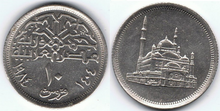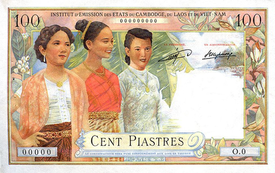Piastre
This articleneeds additional citations forverification.(July 2010) |



Thepiastreorpiaster(English:/piˈæstər/) is any of a number of units of currency. The term originates from the Italian for "thin metal plate". The name was applied to Spanish and Hispanic Americanpieces of eight,orpesos,byVenetiantraders in theLevantin the 16th century.
These pesos, minted continually for centuries, were readily accepted by traders in many parts of the world. After the countries of Latin America had gained independence, pesos of Mexico began flowing in through the trade routes, and became prolific in theFar East,taking the place of the Spanish pieces of eight which had been introduced by the Spanish atManila,and by thePortugueseatMalacca.When the Frenchcolonised Indochina,they began issuing the newFrench Indochinese piastre(piastre de commerce), which was equal in value to the familiar Spanish andMexican pesos.
In theOttoman Empire,the wordpiastrewas a colloquial European name ofKuruş.Successive currency reforms had reduced the value of the Ottoman piastre by the late 19th century so as to be worth about two pence (2d)sterling.Hence the namepiastrereferred to two distinct kinds of coins in two distinct parts of the world, both of which had descended from the Spanish pieces of eight.
Because of the debased values of the piastres in theMiddle East,these piastres became subsidiary units for theTurkish,Cypriot,andEgyptianpounds.[1]Meanwhile, in Indochina, the piastre continued into the 1950s and was subsequently renamed theriel,thekip,and thedonginCambodia,LaosandVietnamrespectively.
As a main unit[edit]
As a sub-unit[edit]
- 1⁄100of theEgyptian pound

- 1⁄100of theJordanian dinar
- 1⁄100of theLebanese pound
- 1⁄100of theSouth Sudanese pound(spelled "piaster" )
- 1⁄100of theSudanese pound
- 1⁄100of theSyrian pound
Obsolete currencies[edit]
- 1⁄180of theCypriot pound
- 1⁄100of theLibyan pound
- 1⁄100of theTurkish lira
Other usage[edit]

Earlyprivatebank currency issues inFrench-speakingregions ofCanadawere denominated in piastres, and the term continued in official use for some time as a term for theCanadian dollar.For example, the original French version of the 1867Constitution of Canadarefers to a requirement that senators hold propertyd'une valeur de quatre mille piastres.
The term is still unofficially used inQuebec,Acadian,Franco-Manitoban,andFranco-Ontarianlanguage as a reference to the Canadian dollar, much as English speakers say "bucks." (The official French term for the modern Canadian dollar isdollar.) When used colloquially in this way, the term is often pronounced and spelled "piasse" (pl. "piasses" ). It was equivalent to 6New France livresor 120 sous, a quarter of which was "30 sous", which is also still in slang use when referring to 25 cents.
Piastrewas also the original French word for theUnited Statesdollar, used for example in the French text of theLouisiana Purchase.Calling the US dollar a piastre is still common among speakers ofCajun FrenchandNew England French.Modern French usesdollarfor this unit of currency as well. The term is still used as slang for US dollars in theFrench-speaking Caribbeanislands, most notablyHaiti.
Piastreis another name forkuruş,1⁄100of theTurkish lira.
Thepiastreis still used inMauritiuswhen bidding in auction sales, similarly to the way thatguineasare used at British racehorse auctions. It is equivalent to 2Mauritian rupees.[2]
"Piaster" is referenced in theSteely Dansong Dr. Wu: "You walked in And my life began again Just when I'd spent the last piaster I could borrow"
See also[edit]
References[edit]
- ^Thimm, Carl Albert."Egyptian Money".Egyptian Self-Taught.William Brown & Co., Ltd., St. Mary Axe, London, E.C.
- ^MD, Michael J. Aminoff (24 November 2010).Brown-Sequard: An Improbable Genius Who Transformed Medicine.Oxford University Press.ISBN978-0-19-978064-8– via Google Books.
Further reading[edit]
Eckfeldt, Jacob Reese; Du Bois, William Ewing; Saxton, Joseph (1842).A manual of gold and silver coins of all nations, struck within the past century. Showing their history, and legal basis, and their actual weight, fineness, and value chiefly from original and recent assays. With which are incorporated treatises on bullion and plate, counterfeit coins, specific gravity of precious metals, etc., with recent statistics of the production and coinage of gold and silver in the world, and sundry useful tables.Assay Office of the Mint. p. 132.
